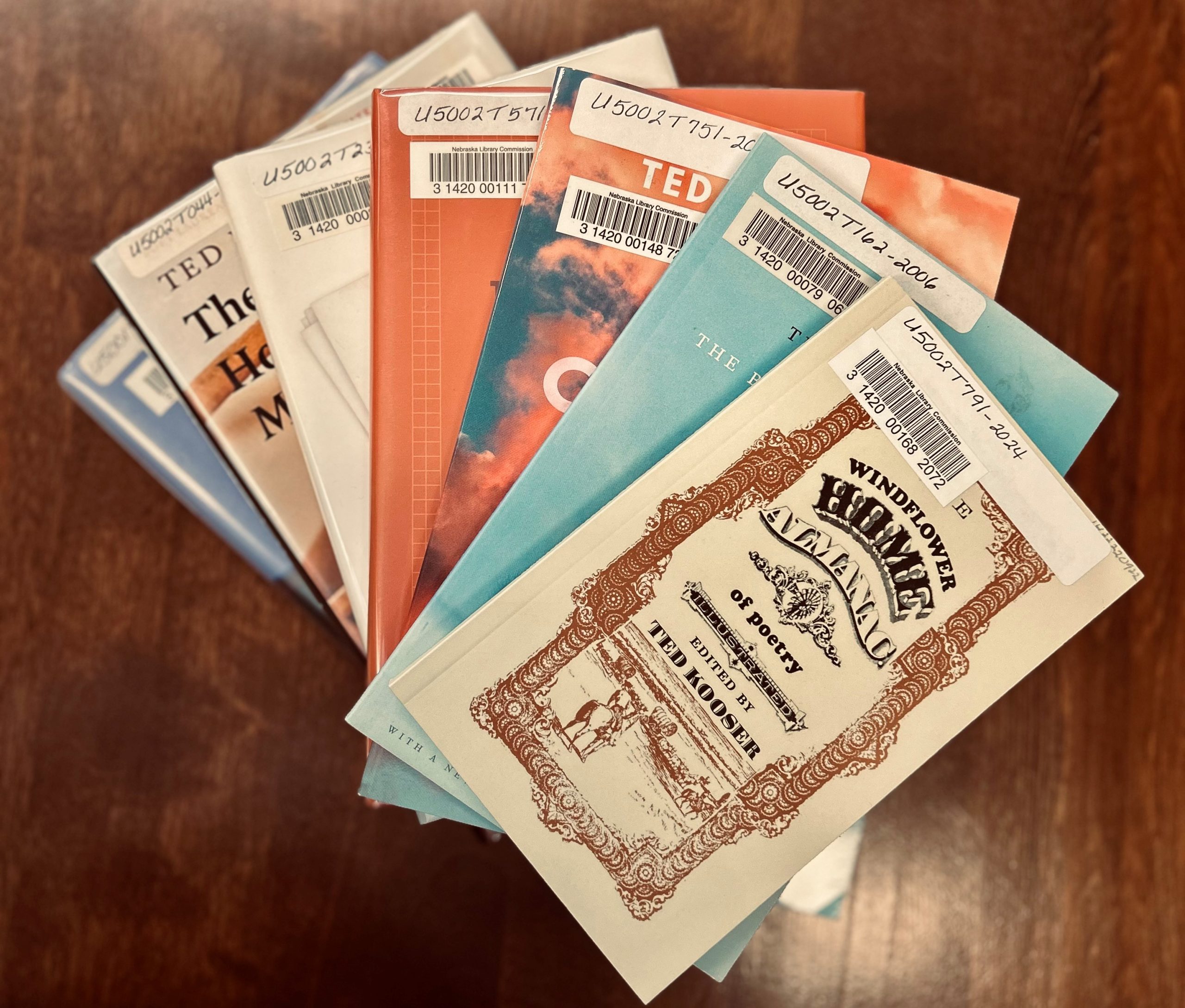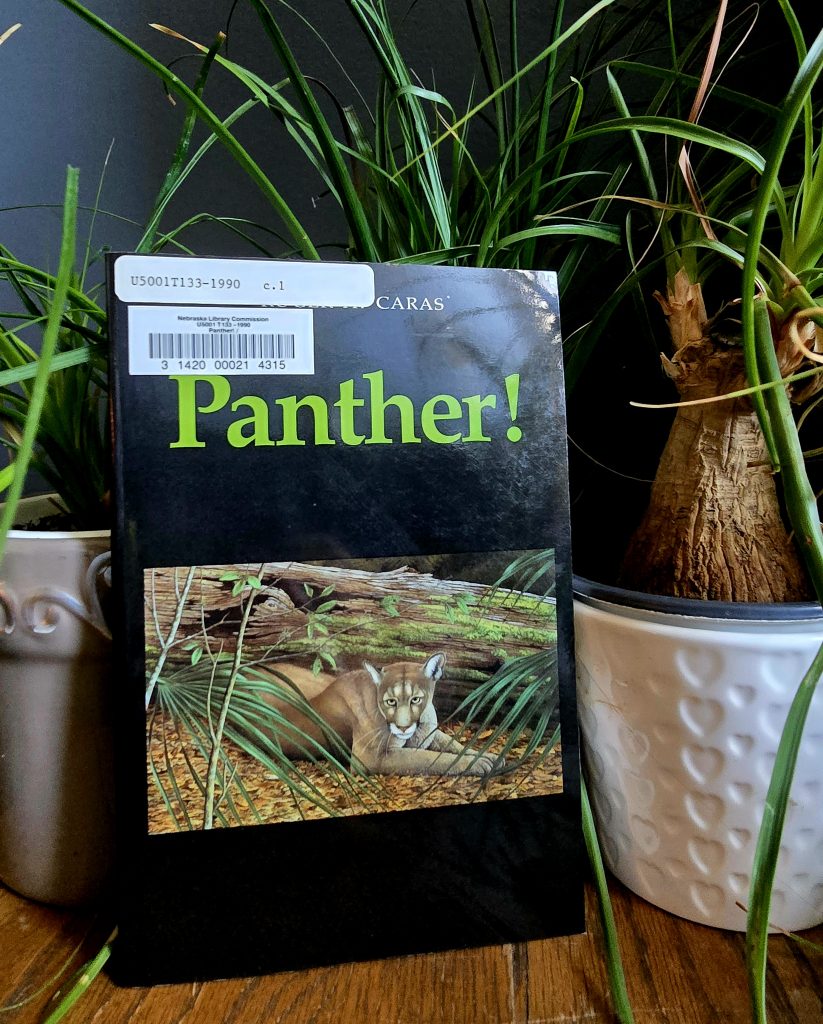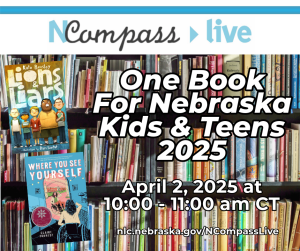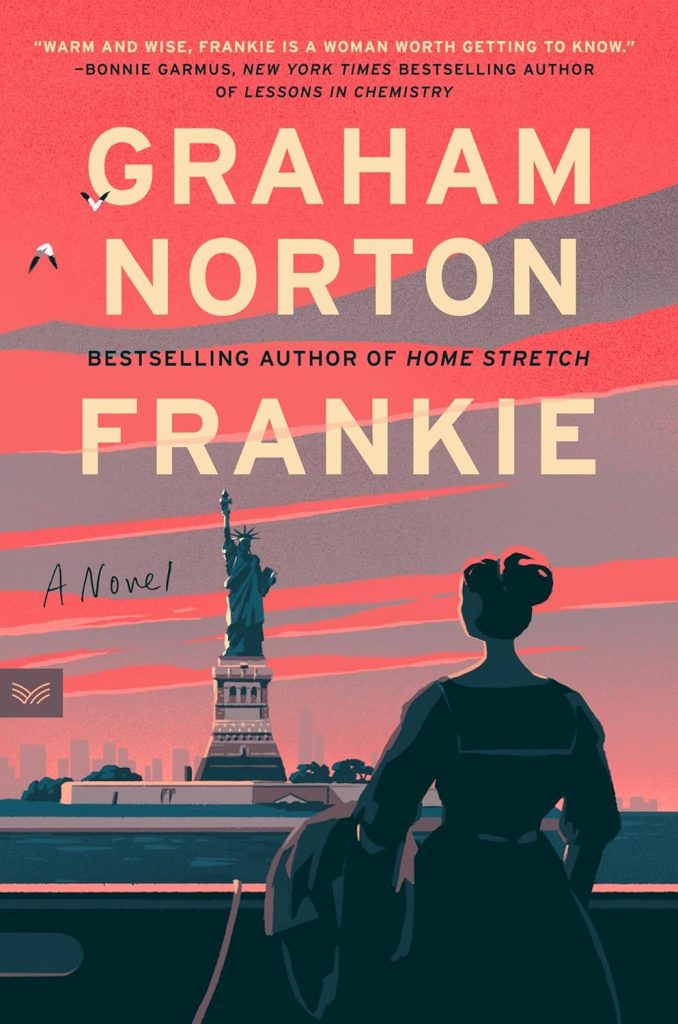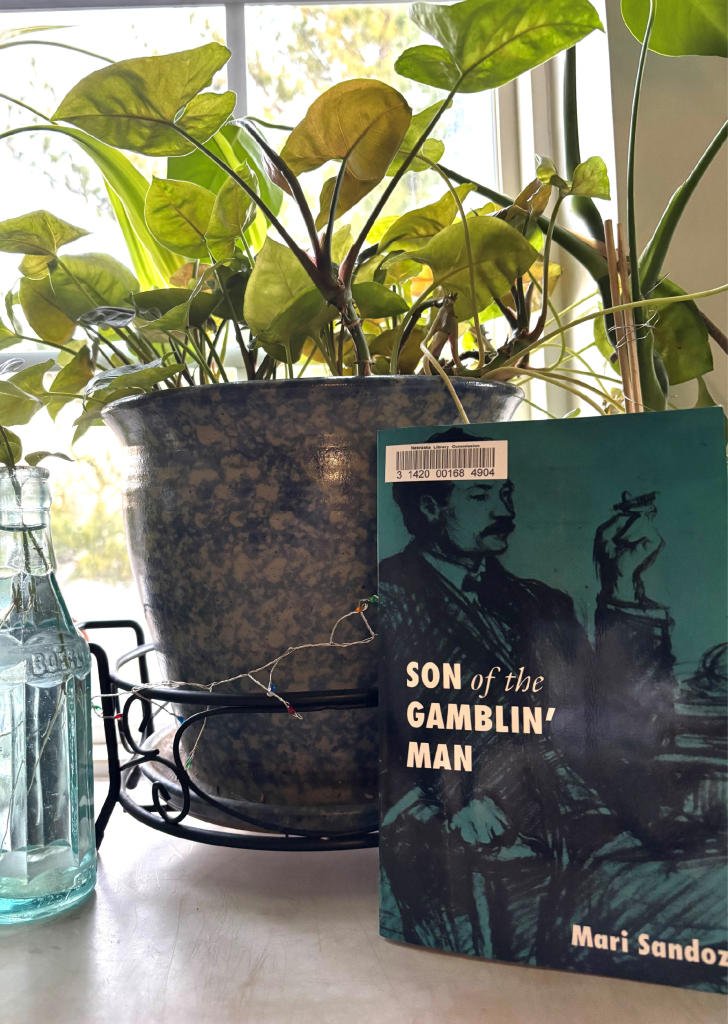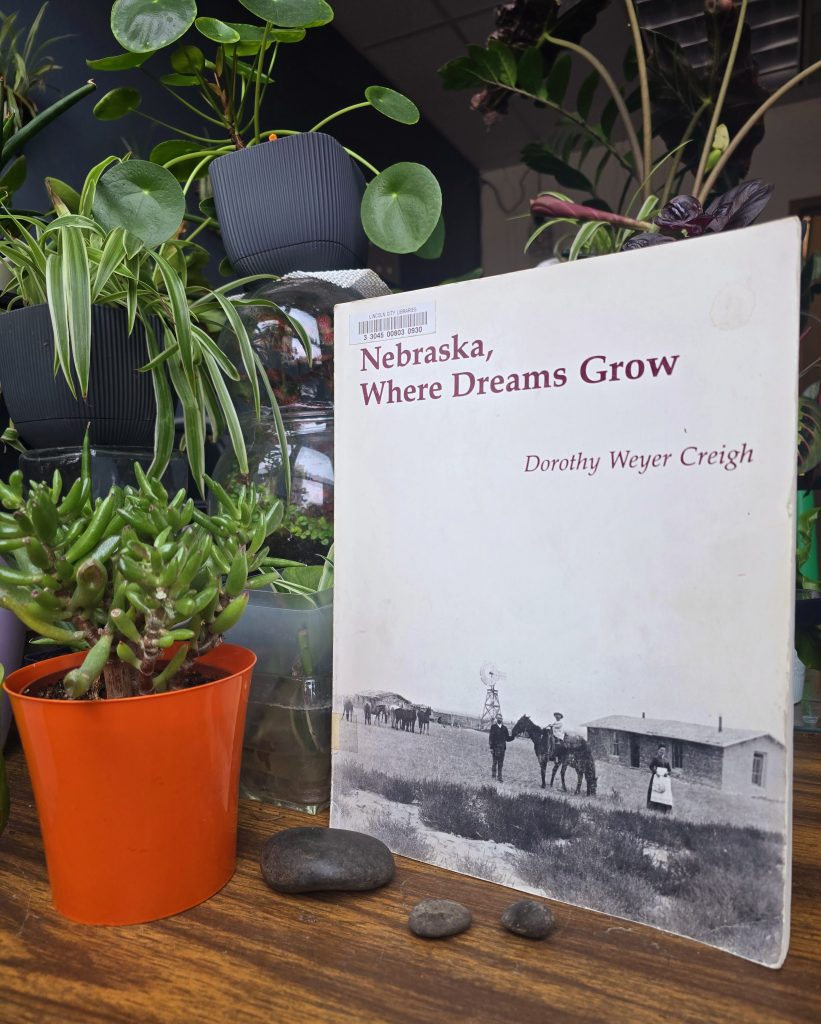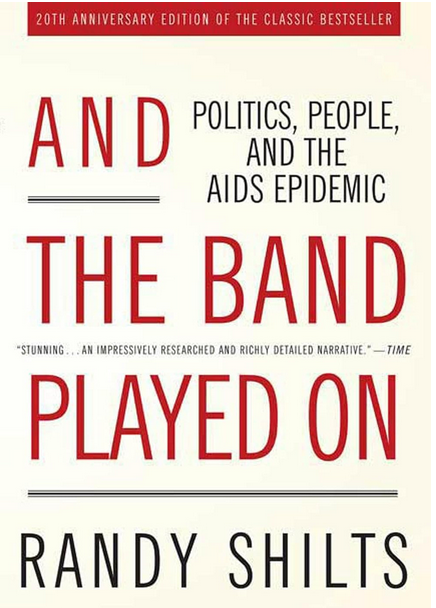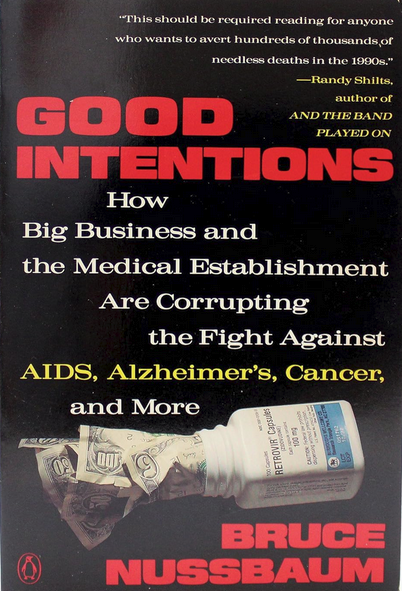Search the Blog
Categories
- Books & Reading
- Broadband Buzz
- Census
- Education & Training
- Friday Reads
- General
- Grants
- Information Resources
- Library Management
- Nebraska Center for the Book
- Nebraska Libraries on the Web
- Nebraska Memories
- Now hiring @ your library
- Preservation
- Pretty Sweet Tech
- Programming
- Public Library Boards of Trustees
- Public Relations
- Talking Book & Braille Service (TBBS)
- Technology
- Uncategorized
- What's Up Doc / Govdocs
- Youth Services
Archives
Subscribe
Category Archives: Books & Reading
Friday Reads: A Lost Lady, by Willa Cather
While I was enjoying some Barbara Stanwyck films on Turner Classic Movies (star of the month for March 2025), I saw something that surprised me—a mention of Willa Cather in the opening credits for A Lost Lady (Warner Bros., 1934). I’d heard of the 1923 book that Willa Cather wrote with that title, but I’d assumed this was a coincidence. I don’t know as much about Willa Cather as many other Nebraskans might (who might also be reading this right now—hello everyone, in the state and elsewhere, who has a Google alert for Willa Cather! You are a devoted bunch!), but I didn’t remember seeing Cather’s name associated with a relatively contemporaneous movie before.
(This 1934 movie was the second attempt to bring the hit novel to the screen. The first try was in 1924, directed by Harry Beaumont and starring Irene Rich—but don’t go looking for that version, because according to IMDb and others, there are no existing prints of that 1924 movie—it’s considered as “lost” as its title character.)
According to film critics in 1934, this second attempt to bring the book to the screen was a disappointment, despite the popular cast. The review in the New York Times suggested changing the title and removing Cather’s name from the credits, and that the film lacked “the haunting beauty of the book.” The 1934 movie was such a disappointment to Cather that it is said to be the reason there were no more movies made of her works in her lifetime.
After looking into the adaptation history, I had to pick up the book. Since A Lost Lady is old enough (1923) to be in the public domain, there are many versions online for reading or listening, as well as many reprints and editions in physical form. The Willa Cather Archive at UNL, for one, has it (and many related materials worth looking at) online.
To be fair, it would have been difficult to make A Lost Lady into a successful movie that stayed faithful to the text. The book opens with setting the physical and social scene in a way that would have been a challenge with the film technology at the time. That is soon followed, in the book, by a scene of animal cruelty and body horror that could not have made it onto the screen at the time either, for other reasons. These limitations might explain why the filmmakers re-ordered the narrative events of the text, but that re-ordering takes away an important “reveal” of some character development. Also, Nebraska, as a place, is missing from the movie entirely.
Another challenge for the film is the casting. If someone read a synopsis of the book but didn’t actually read the book, it would sound great to cast Hayes-Code-inspiring, 1930s-era Barbara Stanwyck, who excelled in playing flawed, charismatic women who would do what it takes to survive. This is what her studio and her fans would want from her performance, and they’d be rooting for her through stumbles and successes—and this is not quite what the book is about.
A Lost Lady (the book) is about a young man, Niel Herbert, who is enthralled with, and eventually disillusioned by, the charming Marian Forrester, who indeed does what it takes to survive, and Niel does not like the choices Marian makes. The book succeeds where the movie flounders, because we see Marian’s do-what-it-takes choices through the gaze of Niel—and Niel is the person with whom Cather intends the reader to identify—not Marian. Also, in the movie, Niel is the same age as Marian, which completely changes their dynamic.
This difference gives nuance to the book, while the movie becomes an ineffective morality play (with a very different ending). One could argue the first half of the movie is more fair to Marian than the book ever is (and then falls apart in a frustrating fashion that I had to re-wind twice so make sure I wasn’t missing something), but, to be fair, the book is never really trying to make excuses for Marian. It’s up to the reader to complete any circuit of sympathy and understanding for the choices she feels she must make. I think the reader can handle this responsibility better than Niel does.
Reviews of the book see symbolism that don’t follow through to the film adaptation. In the book, the reader can see how Niel might represent the American westerner of the era, who’s been promised a promise—a future that’s as bright as one wants it to be. And the Marian of the book might represent the American West—charming, wild, just out of reach, something the protagonist could fall in love with the idea of—but which can’t live up to unreasonable expectations projected upon it, at least not for a member of the current generation, born too late to enjoy what the previous generation seems to have handed to them (of course, it wasn’t handed to them either, and not in any lasting way).
In that sense, A Lost Lady, published in 1923, is an emblematic story for the 1920s, even though much of the action happens earlier. (Correspondence between Cather and F. Scott Fitzgerald noted the similarities of Marian Forrester and Daisy Buchanan, another Roaring Twenties woman-as-embodiment of male desire-turned-to-disillusionment.) Having said that, it’s still a timeless story. Part of growing up is realizing that some things you thought you wanted just won’t make you happy, partly because you didn’t really understand them in the first place.
A Lost Lady is a quick read, or listen—and well worth your time, whether you’re new to Cather or not. (Just remember you don’t actually have to agree with Niel about everything, even if you do agree with him about some things.) Even as such a slim volume, it is lush with the landscape-as-place and dynamic domesticity for which Cather is known and celebrated.
The un-lost 1934 movie might be only for the Barbara Stanwyck completist—if you’re willing to put up with the inconsistencies of her character, and the unfortunate stereotyping of one of the house staff characters, which is more extreme than in the book. I have to note that the Orry-Kelly wardrobe is amazing—it might be the best part of the movie.
Cather, W. (1923). A lost lady. Alfred A. Knopf.
Some additional notes:
Of interest to Barbara Stanwyck and classic film fans: look at this Warner Brothers pressbook for the 1934 movie, courtesy of the Wisconsin Center for Film and Theater Research and The Internet Archive
Also: did you know Barbara Stanwyck married a Nebraska-born fellow Hollywood star a few years after this movie? That would be Robert Taylor.
Of interest to Willa Cather fans who are also Ethel Cain fans (there’s a definite crossover here, if you know, you know): Ethel Cain is going back out on tour in 2025! No stops in Nebraska this time.
Posted in Books & Reading, Friday Reads, General
Tagged Friday Reads, Reading, Willa Cather
Leave a comment
Discovering State Docs: “There Once Was a Man from Nebraska…”
Happy National Poetry Month! When you hear “state government documents” do you immediately think of poetry? Me neither! The Nebraska Publications Clearinghouse receives documents every month from all Nebraska state agencies, including the University of Nebraska Press, which recently sent us Ted Kooser’s “The Windflower Home Almanac of Poetry.” It is a reprint of his original 1980 book, and one of many of his titles we have in this collection.
“The Windflower Home Almanac of Poetry is an anthology of poems originally selected by Ted Kooser in 1980 and published by his Windflower Press, a small, independent publisher that specialized in poetry from the Great Plains. The collection contains almost two hundred poems from dozens of poets and was designed to resemble a commonplace farmer’s almanac.
The Windflower Press was the sole operation of Kooser, who was later named the first U.S. poet laureate from the Great Plains. His press gained national recognition for highlighting the work of the region’s young poets, and its Windflower Home Almanac of Poetry earned notice from the Library Journal as one of its era’s best small press books.”
In the Editor’s Note, Kooser talks about the process of typesetting and pasting the poems together with illustrations he’d collected from old almanacs, long before the advent of software to ease these tasks.
One of the most prestigious academic presses in the country, the University of Nebraska Press sends us around 75 select titles per year, which are added to the Nebraska Publications Clearinghouse, also known as the Nebraska State Documents Collection. This collection is comprised of publications issued by Nebraska state agencies, ensuring that state government information is available to a wide audience and that those valuable publications are preserved for future generations. University of Nebraska Press books, as well as all state documents, are available for checkout by libraries and librarians for their patrons.
Kooser, Ted (Ed.). The Windflower Home Almanac of Poetry. University of Nebraska Press, 2024.
NCompass Live: One Book For Nebraska Kids & Teens 2025
Wouldn’t it be great if kids all over Nebraska were talking about books? Hear about the Nebraska Library Commission & the Regional Library Systems’ program where kids can all read and discuss the same book on next week’s NCompass Live webinar on Wednesday, April 2 at 10am CT.
Join Sally Snyder, the NLC’s Coordinator of Children and Young Adult Library Services; Aimee Owen, Information Services Librarian; and Bailee Juroshek, Office Specialist, to learn all about the One Book for Nebraska Kids and Teens program.
Our 2025 titles are: One Book For Nebraska Kids – Lions & Liars by Kate Beasley, and One Book For Nebraska Teens – Where You See Yourself by Claire Forrest.
Upcoming NCompass Live shows:
- April 30 – Pretty Sweet Tech: Computers in Libraries 2025 Highlights & Trends
To register for an NCompass Live show, or to listen to recordings of past shows, go to the NCompass Live webpage.
NCompass Live is broadcast live every Wednesday from 10am – 11am Central Time. Convert to your time zone on the Official U.S. Time website.
The show is presented online using the GoTo Webinar online meeting service. Before you attend a session, please see the NLC Online Sessions webpage for detailed information about GoTo Webinar, including system requirements, firewall permissions, and equipment requirements for computer speakers and microphones.
Friday Reads & BookFace Friday: “Frankie” by Graham Norton
You’ll want to get to know this #BookFace!
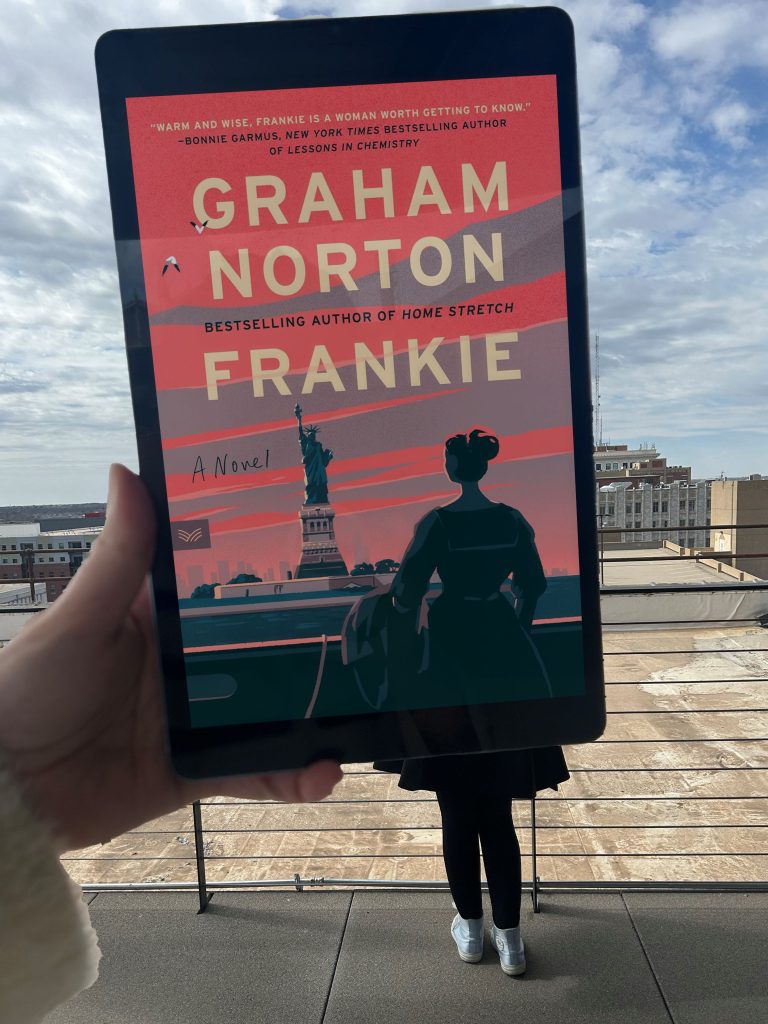
I am always interested in anything Graham Norton writes and when his fifth audio book of fiction was released with Norton’s narration, I saved it for a long weekend of listening. Graham often sets his books in Ireland but this book expands to London and New York City following the very full life of the title character from age 10 to her 80s. The story begins with Irish born Frankie recovering from an injury with the assistance of a home health care worker named Damian in her London flat. Damian is also Irish and the two enjoy an easy rapport. Frankie’s home is filled to the brim with souvenirs and boxes of memorabilia that provide easy conversation starters. As Frankie tells the stories of her past, both listeners benefit therapeutically. In one poignant moment, Frankie asks Damian if his heart has ever been broken. His answer is naive and honest, even more so given Frankie’s history. Frankie regains her mobility and Damian departs for other assignments but not until they celebrated their newfound friendship.
I found myself talking about this book to my reader friends but never did I say, this could be something they might like to read. The Irish authors I’ve read have a definite tone to their work. It’s pragmatic and practical. The characters know that if life is going smoothly, they ought to appreciate it because it will all come to an end sooner rather than later. There are moments of great passion and love in Frankie’s life, but also tragedy and heartbreak. It’s the unequal ratio toward more sadness that makes it Irish fiction in my opinion and that can be a tough sell. Even so, I will continue to read Norton’s works because he is a brilliant storyteller and narrator. This was my favorite of Graham’s novels and I missed Frankie for days after I finished the book.
Norton, Graham. Frankie. HarperVia, 2025.
Love this #BookFace or #FridayReads? Check out our past posts on the Nebraska Library Commission’s Facebook page!
Posted in Books & Reading, Friday Reads, General
Tagged bookface, bookfacefriday, Frankie, Friday Reads, Graham Norton
Leave a comment
Book Club Spotlight – Mad Honey
Written by bestselling authors Jodi Picoult and Jennifer Finney Boylan, today’s Book Club Spotlight, Mad Honey, was made possible by the power of the internet and a (literal) dream. Known for their thoughtful and provoking works, Picoult, a writer on complex and controversial issues, and Boylan, the President of PEN America, combine their talents into a riveting story of love, identity, and tragedy. As Women’s History Month ends with the celebration of International Transgender Day of Visibility on the 31st, both topics are at the heart of today’s Spotlight.
“Mad Honey”- a sweet comfort turned poison by the pollinators we thought we could trust. In a small New Hampshire town, beekeeper Olivia McAfee has worked hard to keep her teenage son away from the world’s poison, including her abusive ex-husband. But now Asher’s girlfriend, Lily, is dead, and all fingers point towards him. All the while, Lily’s own story falls back through time, from the day she died to her first meeting with Asher. It was true love. Sure, he could get angry, but it was love- wasn’t it? In the present, Olivia must work through the pain of seeing her child accused of murder, not knowing if she can trust the boy she raised, while mourning for the tender girl they lost.
“Everybody is always still trying to learn, day after painful day, how to be themselves. I can’t wait”
– Jodi Picoult and Jennifer Finney Boylan
Told in dual timelines, Mad Honey shines in one cohesive text, drawn together by the dangerous reality of womanhood. The reader, like Olivia, goes back and forth throughout the novel, unsure of Asher’s innocence, scared that he’s not. But will the truth change the reality of Lily’s fate? A suspenseful novel for mature young adults and adult Book Club Groups, Mad Honey asks how much our identities and the past shape us. And how far would we go to defend a loved one. For fans of Picoult, her recurring character Jacob McAfee from The Pact, Nineteen Minutes, and Salem Falls makes an appearance as the family’s whip-smart lawyer.
If you’re interested in requesting Mad Honey for your book club, you can find the Request Form here. There are 5 copies. (A librarian must request items)
Picoult, Jodi and Jennifer Finney Boylan. Mad Honey. Ballantine Books, 2022.
Friday Reads: “The Berry Pickers: A Novel” by Amanda Peters
This historical fiction novel set in 1960s New England follows two families whose paths cross alongside a dirt road and are then forever entwined. Joe and his family are Mi’kmaq, they travel down from Nova Scotia every year to work the berry fields of Maine. His day begins as any other but when he fails to keep an eye on his four year old sister Ruthie, he will spend the rest of his life trying to atone for her disappearance.
Norma has grown up in a sheltered and isolated suburban home with a mother that always seems afraid to let her out of her sight. She doesn’t remember much of her early childhood, but her parent’s distress when she asks about it or mentions her imaginary friend Ruthie has taught her to keep questions to herself. As she grows up her assumption that she’s adopted, and her parents never wanted to tell her will be shaken by a more awful truth. The Berry Pickers follows the aftermath of one family’s tragedy and another’s sins as both try to move forward after the loss of a child. Peter’s weaves these two dramatically different family stories together, exploring themes of family, guilt, and identity. It was the winner of the Andrew Carnegie Medal for Excellence in Fiction, and the 2024 selection for One Book One Lincoln by Lincoln City Libraries.
Peters, Amanda. The Berry Pickers: A Novel. Catapult. 2023.
Posted in Books & Reading, Friday Reads, General
Tagged Alex Michaelides, Book Review, books, Friday Reads, Novel, Reading, The Maidens
Leave a comment
#BookFaceFriday “Catherine the Great: Portrait of a Woman” by Robert K. Massie
It’s the reign of #BookFaceFriday!
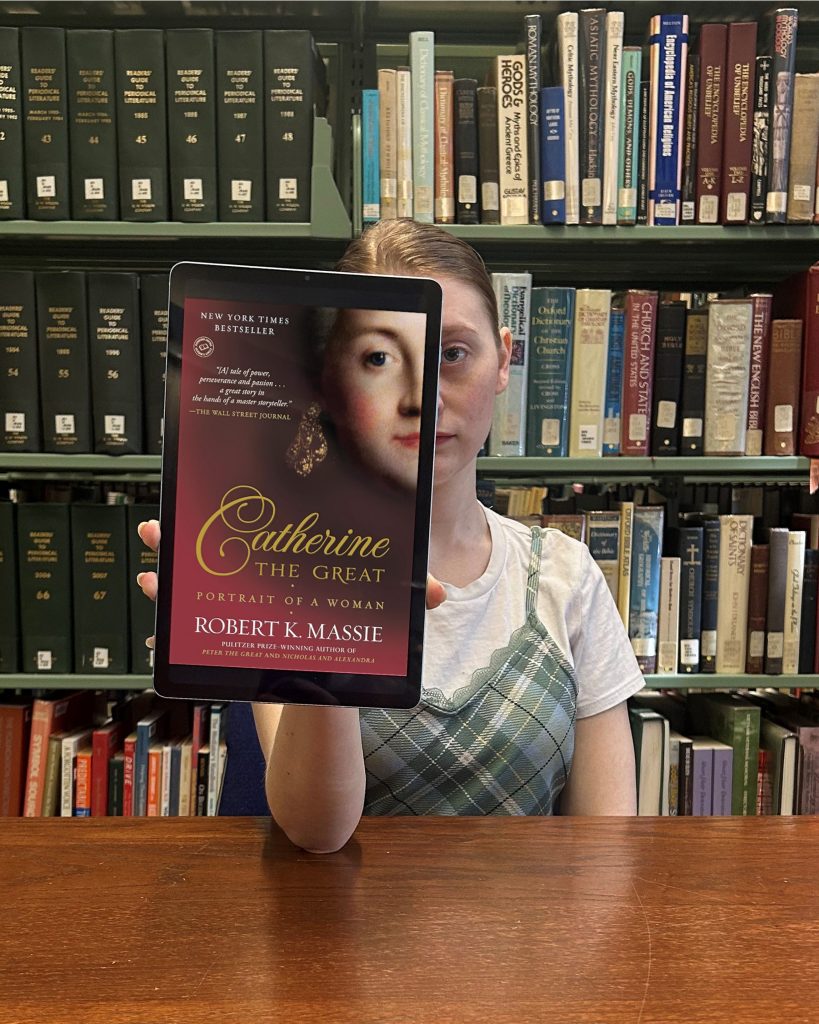
Happy Woman’s History Month! “Catherine the Great: Portrait of a Woman” by Robert K. Massie (Random House Trade Paperbacks, 2012) is a narrative biography that delves into the story and history of Catherine the Great.
It’s available as an eBook and Audiobook through Nebraska OverDrive Libraries and is currently featured in the “Woman’s History” curated collection, along with many other novels highlighting woman throughout history.“[A] meticulously detailed work about Catherine and her world. . . . Massie makes Catherine’s story as gripping as that of any novel. His book does full justice to a complex and fascinating woman and to the age in which she lived.”
— Historical Novels Review
Libraries participating in the Nebraska OverDrive Libraries Group currently have access to a shared and growing collection of digital downloadable audiobooks and eBooks. 194 libraries across the state share the Nebraska OverDrive collection of 26,898 audiobooks, 36,794 ebooks, and 5,133 magazines. As an added bonus it includes 130 podcasts that are always available with simultaneous use (SU), as well as SU ebooks and audiobook titles that publishers have made available for a limited time. If you’re a part of it, let your users know about this great title, and if you’re not a member yet, find more information about participating in Nebraska Overdrive Libraries!
Love this #BookFace & reading? We suggest checking out all the titles available for book clubs at http://nlc.nebraska.gov/ref/bookclub. Check out our past #BookFaceFriday photos on the Nebraska Library Commission’s Facebook page!
Big Talk From Small Libraries 2025 Recordings Now Available
Recordings of all Big Talk From Small Libraries 2025 sessions are now available!

You will find the recordings and presentations on the 2025 Recordings & Presentations page.
Don’t forget to complete the conference Evaluation! We’re looking for input from people who attended the live conference and watched the archived recordings.
And mark your calendars now – Big Talk From Small Libraries will be back in 2026! Next year’s conference will be on Friday, February 27, 2026!
#BookFaceFriday “Very Bad at Math” by Hope Larson
You can always count on #BookFaceFriday!
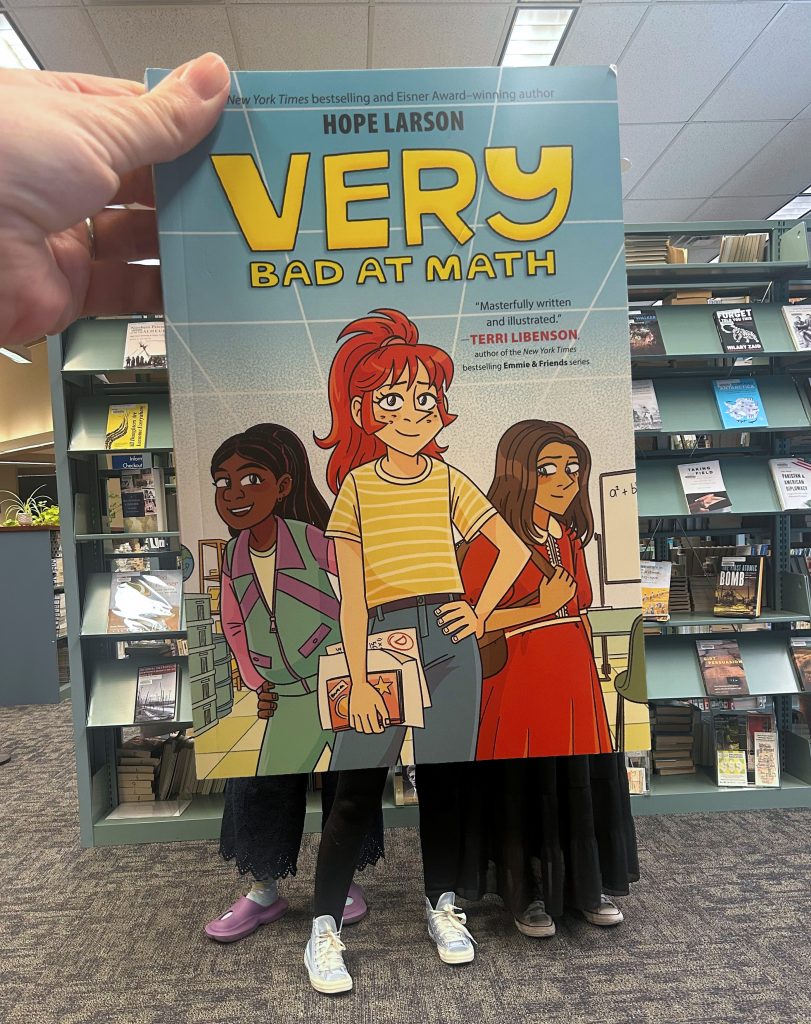
Everything is adding up! This week’s #BookFace, “Very Bad at Math” by New York Times bestselling and Eisner Award–winning author Hope Larson (HarperAlley, 2025) is a colorful middle grade graphic novel. Verity “Very” Nelson can do it all, except math! All seems lost until a teacher helps her discover the truth: Verity has dyscalculia, a learning disability that causes her to mix up numbers.
“Graphic novelist Larson has aimed her latest story at middle-grade readers who…will make a lot of readers feel seen. A solid addition.”
—Booklist
The Nebraska Library Commission receives a large number of children’s and young adult books sent to us as review copies from book publishers. When our Children and Young Adult Library Services Coordinator, Sally Snyder, is done with them, the review copies are available for the Library System Directors to distribute to school and public libraries in their systems. You can see some of her favorites of the past year in the recent NCompass Live webinar episodes: Best Teen Reads of 2024 and Best Children’s Books of 2024.
Love this #BookFace & reading? Check out our past #BookFaceFriday photos on the Nebraska Library Commission’s Facebook page!
Friday Reads: At Wit’s End: Cartoonists of The New Yorker – Photographs by Alen MacWeeney Words by Michael Maslin
The New Yorker magazine celebrates its 100th anniversary this year. At Wit’s End is perfectly timed to showcase cartoonists and cartoons that have been a consistent part of the magazine since its inception. Wit’s End is a truly fun book and one that diverts from books many of us typically read. The New Yorker has provided readers with hundreds of thousands of cartoons from over 700 cartoonists that delight, capture, and depict the happenings of the time. Whether pop culture, politics, or other, The New Yorker cartoonists drill into topics of the day with skilled artwork and clever captions. With or without captions, cartoonists tell stories within the art of a single-frame cartoon.
It might be that I’ve been a decades long subscriber to The New Yorker magazine for its cartoons and covers. And that may be why I had to get a copy of At Wit’s End after reading a review. Every once in a while, it is fun to spend time with a book that amuses and fascinates. I found that in this book.
In At Wit’s End, Michael Maslin, a cartoonist himself, profiles 50 some of The New Yorker cartoonists selected from the hundreds whose cartoons have been published in the magazine over the past century. Some of the cartoonists have been contributors over many decades and some are newer and more recent magazine cartoon contributors. Ed Koren, for one, is among just a couple of dozen who have sold more than two thousand drawings. A typical reader likely knows little about the cartoonist but will readily recognize their style. That’s why it is a joy to learn about the cartoonist behind the cartoon aptly profiled by Maslin. The cartoonists are uniquely creative with atypical personalities, even eccentric perhaps.
The cartoonist profiles are complemented with Alen MacWeeney’s photographs and a sampling of single-panel cartoons depicting the cartoonist’s style. The New Yorker readers no doubt have their favorite cartoonists. Mine include George Booth, Charles Addams, William Steig, David Sipress, James Thurber, and Robert Mankoff (The New Yorker cartoon editor for over two decades), and there are many more. For the record, mentionable are a couple of well-known cartoon captions – Peter Steiner’s “On the internet, nobody knows you’re a dog” and Bob Mankoff’s “No, Thursday’s out. How about never – is never good for you?”
From 1997-2012 The New Yorker published an annual Cartoon issue. The magazine’s Cartoon Caption Contest began in the 1998 Cartoon issue and has continued as a weekly feature since 2005. The feature, near the back pages of the issue, includes the new contest cartoon, three finalists, and the winning caption.
Cartoonist Michael Maslin is a notable writer as well and whose Ink Spill Blog is “The go-to chronicle of all things New Yorker cartoon.” Photographer Alen MacWeeney is an internationally celebrated photographer whose photographs accompany cartoonist profiles in At Wit’s End.
MacWeeney, Alen, and Maslin, Michael, Alen. At Wit’s End: Cartoonists of The New Yorker. Clarkson Potter, 2024.
Book Club Spotlight – The Samurai’s Garden
Today’s Book Club Spotlight is a beautiful and heart-wrenching story of two nations whose fates are intertwined for better and worse. Of Chinese and Japanese descent, Gail Tsukiyama’s 1994 novel The Samurai’s Garden meditates on the treacherous history between her two cultures and finds humanity in the smallest of places. Traditional Japanese gardens, like those featured in the story, are said to be founded on ancient Chinese gardening techniques. And their unique artistry and storytelling through landscape make them renowned locations of peace and tranquility. This is not unlike the change and peace our Chinese protagonist finds during his time living in rural Japan during the Second Sino-Japanese War and the Nanjing (Nanking) Massacre. The recipient of numerous literary awards, Tsukiyama is the current Executive Director of the non-profit WaterBridge Outreach, which provides developing countries with literary material and access to clean water and sanitation.
All the young and able men are off fighting in China for the Japanese Empire, with each loss and success clouding those they have left at home. But despite the war, life goes on in the peaceful seaside village of Tarumi. And nestled on the outskirts of town is Chinese student Stephen, who has come to his family’s summer home to recuperate from tuberculosis. There, he finds a quiet spirituality in Japan that he never had in his busy Hong Kong home, watching as the diligent and quiet groundskeeper Matsu tends tirelessly to the expansive landscape garden. Over the course of a year, amongst the peaceful moss and trees, the story of Matsu and the people of the village come into focus as the pain of the past is superimposed on the pain of the present. Love is forged and lost, while Stephen’s heart is torn by the brutalities his people are facing at the hands of the very country in which he is finding peace.
“Even if you walk the same road a hundred times, you’ll find something different each time.”
– Gail Tsukiyama
In The Samurai’s Garden, our main character is sent away from his home to recover from Tuberculosis, far from all he knows. And he is not the only one there who is struggling with the isolation of illness. In a nearby leprosy village, Stephen sees first-hand the repercussions of the historical ostracization of these outcast people, if they even made it that far to begin with. Book Club Groups from teens and above will appreciate the thoughtful discussion on personal survival, honor, and humanity while learning about the different meanings of Japanese gardens which bring the story to life. Tsukiyama explores that while living in turbulent and painful times, we can find peace and beauty in nature and each other, how we can choose kindness and acceptance, even if the world is telling us to turn to hate.
More on Japanese Gardens:
- The Japanese Garden Society: Learn
- Types of Japanese Gardens
- Matsu’s garden is a Tsukiyama (like the author’s name!)
More about Tuberculosis:
- World Tuberculosis Day (March 24th, 2025)
If you’re interested in requesting The Samurai’s Garden for your book club, you can find the Request Form here. There are 8 copies. (A librarian must request items)
Tsukiyama, Gail. The Samurai’s Garden. St. Martin’s Press. 1994.
#BookFaceFriday “The Dream Lover” by Elizabeth Berg
#BookFaceFriday come rescue me!
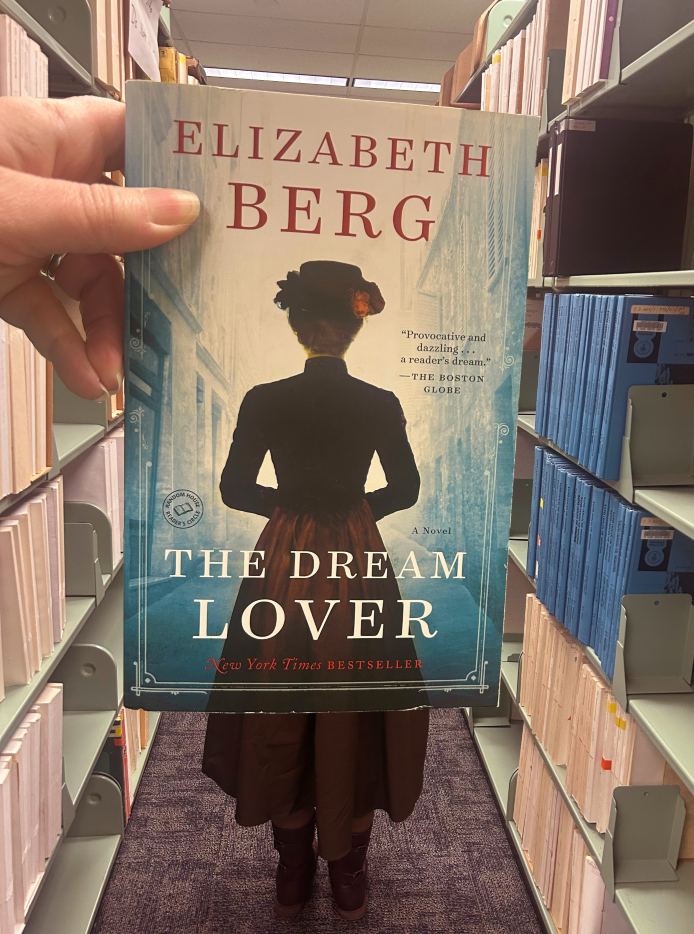
This #BookFaceFriday is a dream come true! At the beginning of “The Dream Lover” by Elizabeth Berg (Ballantine Books; Reprint edition; 2016), Aurore Duplin is leaving her estranged husband and life behind to move to Paris and pursue her dream of becoming a writer under the new name of George Sand.
We have 3 copies for your reading group to borrow in our Book Club Kit collection, and you can also find it in ebook format in the Nebraska OverDrive Libraries.“Fantastic . . . a provocative and dazzling portrait . . . Berg tells a terrific story, while simultaneously exploring sexuality, art, and the difficult personal choices women artists in particular made—then and now—in order to succeed. . . . The book, imagistic and perfectly paced, full of dialogue that clips along, is a reader’s dream.”
— The Boston Globe
Book Club Kits Rules for Use
- These kits can be checked out by the librarians of Nebraska libraries and media centers.
- Circulation times are flexible and will be based upon availability. There is no standard check-out time for book club kits.
- Please search the collection to select items you wish to borrow and use the REQUEST THIS KIT icon to borrow items.
- Contact the Information Desk at the Library Commission if you have any questions: by phone: 800/307-2665, or by email: Information Services Team
Libraries participating in the Nebraska OverDrive Libraries Group currently have access to a shared and growing collection of digital downloadable audiobooks and eBooks. 194 libraries across the state share the Nebraska OverDrive collection of 26,898 audiobooks, 36,794 ebooks, and 5,133 magazines. As an added bonus it includes 130 podcasts that are always available with simultaneous use (SU), as well as SU ebooks and audiobook titles that publishers have made available for a limited time. If you’re a part of it, let your users know about this great title, and if you’re not a member yet, find more information about participating in Nebraska Overdrive Libraries!
Love this #BookFace & reading? Check out our past #BookFaceFriday photos on the Nebraska Library Commission’s Facebook page!
Friday Reads: Mastering the Art of French Eating by Ann Mah
When Ann Mah moved to Paris in 2008, she envisioned three glorious years of exploring the French cuisine. Living in Paris was a dream come true for Ann, a freelance food writer, and she had always imagined exploring it with her “favorite person,” her husband. The couple was accustomed to moving frequently, but after only a month in Paris, her husband, a foreign diplomat, was called to serve in Baghdad for a year. Ann is suddenly forced to change her expectations and explore France on her own.
Mastering the Art of French Eating: From Paris Bistros to Farmhouse Kitchens, Lessons in Food and Love focuses on Ann Mah’s first year in Paris. Each chapter is devoted to a different French dish like steak frites, crepes, soupe au pistou, and cassoulet. She also explores the history of each dish and connects with those who make them today. Recipes are included if you want to make them at home.
Her need for crepes reminded me of my Chinese mother, who can’t go more than a day without a bowl of rice, or my Italian friend Gianfranco, who requires regular infusions of pasta, or even Didier, who once told me that he missed cheese so much on a trip to South Africa that he ate an entire wheel of Camembert on the airplane home. Crepes, I realized, were a Breton’s comfort food.
The strengths of this memoir are in the exploration of French cuisine and its history, but it is also about navigating loneliness and independence, and exploring identity. Although Ann has a lot of experience traveling and living abroad, she is not comfortable doing those things alone. Her experience has always been with a parent or partner. At times I wanted to reach into the book and shake her as she wastes a lot of time wallowing in loneliness. She struggles to find her own joy, but by connecting with others, she also learns about herself.
How does a cross-cultural seesaw affect a person’s identity? Perhaps if I learned more about Alsace and its cuisine, I could better understand what might happen to me, an American of Chinese ethnicity who changed countries every three to four years.
If you want to explore more of Ann Mah’s writing, you can also check out two of her novels inspired by France in Nebraska Overdrive.
Mah, Ann. Mastering the Art of French Eating: From Paris Bistros to Farmhouse Kitchens, Lessons in Food and Love. Penguin Books, 2013.
Book Briefs: New University of Nebraska Press Books at the Nebraska Publications Clearinghouse
The Nebraska Publications Clearinghouse receives documents every month from all Nebraska state agencies, including the University of Nebraska Press (UNP). UNP books, as well as all Nebraska state documents, are available for checkout by libraries and librarians for their patrons.
Here are the UNP books the Clearinghouse received in January and February, 2025:
The Complete Letters of Henry James, 1888-1891, Volume 1, by Henry James, edited by Michael Anesko, et al. Series: The Complete Letters of Henry James
This first volume in The Complete Letters of Henry James, 1888–1891 contains 171 letters, of which 119 are published for the first time, written from late November 1888 to April 20, 1890. These letters continue to mark Henry James’s ongoing efforts to care for his sister, develop his work, strengthen his professional status, build friendships, engage with timely political and economic issues, and maximize his income, which included hiring an agent. James details his work on The Tragic Muse, “Mrs. Temperly,” “An Animated Conversation,” “The Solution,” and other fiction. This volume opens with James in France and concludes with James on the Continent. Dee MacCormack introduces the volume, paying close attention to James’s increasing interest in the theater.
Men of God : Medicant Orders in Colonial Mexico, by Asunción Lavrin. Series: Confluencias
A broadly researched cultural history, Men of God offers a path to understanding the concept of religious masculinity through an intimate approach to the study of friars and lay brothers in colonial Mexico. Though other scholars have focused on the missionary work of the Augustinian, Franciscan, and Dominican friars, few have addressed their everyday lives and how the internal discipline of their orders shaped them. In Men of God Asunción Lavrin offers a sweeping yet intimate history of the mendicant friars in New Spain from the late sixteenth through the eighteenth centuries.
Focusing on these individuals’ lives from childhood through death, Lavrin explores contemporaneous ideas, from how to raise a boy to the friars’ training as novices, and the similarities and differences in the life experiences of lay brothers and ordained members. She discusses their sexuality to reveal the challenges and failures of religious manhood, as well as the drive behind their missionary duties, especially in the late seventeenth through the eighteenth centuries. Men of God also explores the concepts and realities of martyrdom and death, significant elements in the spirituality of the mendicant friars of colonial Mexico.
Of Corn and Catholicism : a History of Religion and Power in Pueblo Indian Patron Saint Feast Days
In Of Corn and Catholicism Andrea Maria McComb Sanchez examines the development of the patron saint feast days among Eastern Pueblo Indians of New Mexico from the seventeenth century to the late nineteenth century. Focusing on the ways Pueblo religion intertwined with Spanish Catholicism, McComb Sanchez explores feast days as sites of religious resistance, accommodation, and appropriation. McComb Sanchez introduces the term “bounded incorporation” to conceptualize how Eastern Pueblo people kept boundaries flexible: as they incorporated aspects of Catholicism, they changed Catholicism as well, making it part of their traditional religious lifeway.
McComb Sanchez uses archival and published primary sources, anthropological records, and her qualitative fieldwork to discuss how Pueblo religion was kept secret and safe during the violence of seventeenth-century Spanish colonialism in New Mexico; how Eastern Pueblos developed strategies of resistance and accommodation, in addition to secrecy, to deal with missionaries and Catholicism in the eighteenth and early nineteenth centuries; how patron saint feast days emerged as a way of incorporating a foreign religion on the Pueblos’ own terms; and how, by the later nineteenth century, these feast days played a significant role in both Pueblo and Hispano communities through the Pueblos’ own initiative.
Unsettling Cather, by Marilee Lindemann and Ann Romines. Series: Cather Studies, Volume 14
American author Willa Cather was born and spent her first nine years in the Shenandoah Valley of Virginia. Here, as an observant daughter of a privileged white family, Cather first encountered differences and dislocations that remained lively, productive, and sometimes deeply troubling sites of tension and energy throughout her writing life.
The essays in Cather Studies, Volume 14 seek to unsettle prevailing assumptions about Cather’s work as she moved from Virginia to Nebraska to Pittsburgh to New York City to New Mexico and farther west, and to Grand Manan Island. The essays range from examinations of how race shapes and misshapes Cather’s final novel, Sapphira and the Slave Girl, to challenges to criticisms of her 1935 novel, Lucy Gayheart. Contributors also frame fresh discussions of Cather’s literary influences and cultural engagements in the first decade of her career as a novelist through the lens of sex and gender and examine Cather’s engagements with region as a geopolitical, sociolinguistic, and literary site. Together, the essays offer compelling ways of seeing and situating Cather’s texts—both unsettling and advancing Cather scholarship.
**Pictures and Synopses courtesy of University of Nebraska Press.
What’s Up Doc? New State Agency Publications at the Nebraska Library Commission
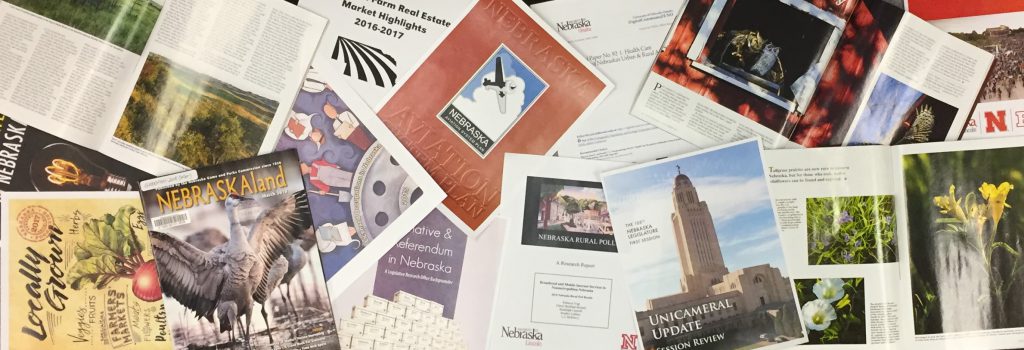
New state agency publications have been received at the Nebraska Library Commission for January and February, 2025. Included are reports from the Nebraska Auditor of Public Accounts, the Nebraska’s Coordinating Commission for Postsecondary Education, the Nebraska Department of Environment and Energy, various Nebraska Legislative Committees, and titles from University of Nebraska Press, to name a few.
With the exception of the University of Nebraska Press titles, items are available for immediate viewing and printing by clicking directly in the .pdf below. The University of Nebraska Press titles can be checked out by librarians for their patrons here: Online Catalog.
The Nebraska Legislature created the Nebraska Publications Clearinghouse in 1972 as a service of the Nebraska Library Commission. Its purpose is to collect, preserve, and provide access to all public information published by Nebraska state agencies. By law (State Statutes 51-411 to 51-413) all Nebraska state agencies are required to submit their published documents to the Clearinghouse. For more information, visit the Nebraska Publications Clearinghouse page, contact Aimee Owen, Government Information Services Librarian; or contact Bonnie Henzel, State Documents Staff Assistant.
Posted in Books & Reading, Education & Training, General, Information Resources, What's Up Doc / Govdocs
Tagged books, GovDocs, Reading
Leave a comment
#BookFaceFriday “Birding with Benefits” by Sarah T. Dubb
Is that a #BookFaceFriday I see?
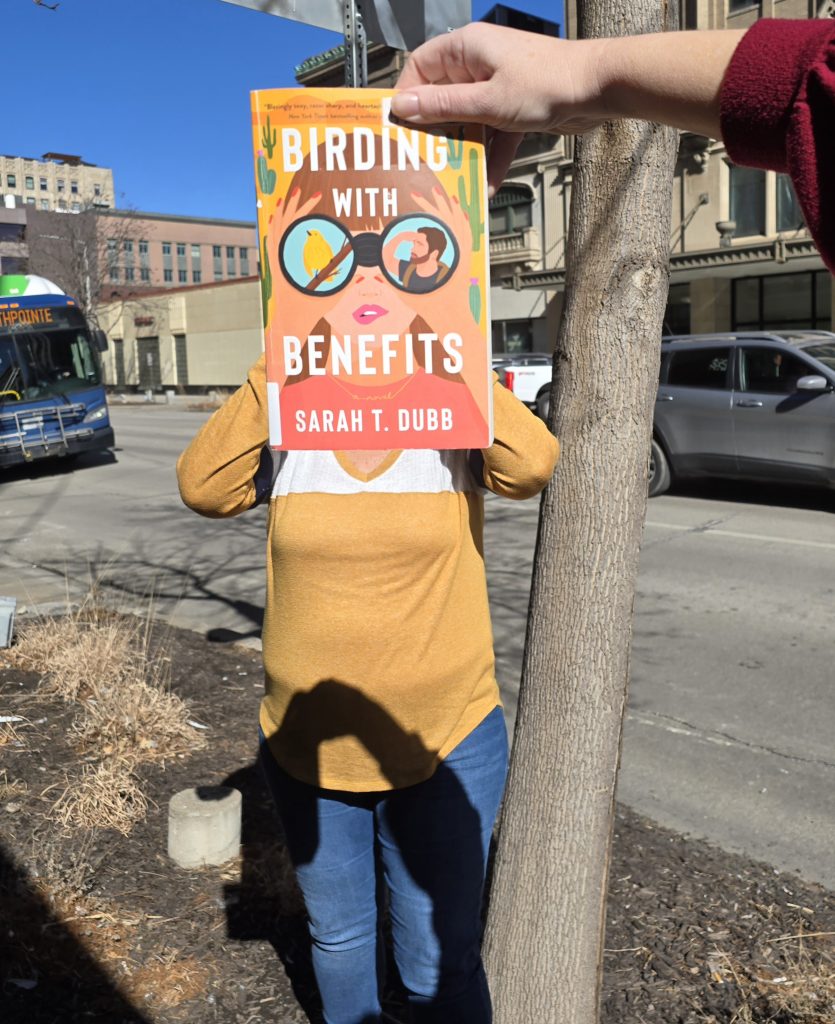
The sun is shining and the birds are flying! If the springtime weather has you in the mood for romance then this #BookFace has you covered! “Birding with Benefits”, Sarah T. Dubb’s debut novel (Gallery Books, 2024), follows divorcee Celeste on her “year of yes” which leads her to John, the shy but sensitive birdwatcher.
It’s available as an eBook through Nebraska OverDrive Libraries, and if you’re looking for more contemporary rom-coms the featured “You Turn My Pages” curated collection available on OverDrive is the perfect place to look!“The slowly simmering romance that blossoms between plucky heroine and heart-of-gold hero results in some love scenes that are as hot as the desert sun in July.”
— Booklist (starred review)
Libraries participating in the Nebraska OverDrive Libraries Group currently have access to a shared and growing collection of digital downloadable audiobooks and eBooks. 194 libraries across the state share the Nebraska OverDrive collection of 26,898 audiobooks, 36,794 ebooks, and 5,133 magazines. As an added bonus it includes 130 podcasts that are always available with simultaneous use (SU), as well as SU ebooks and audiobook titles that publishers have made available for a limited time. If you’re a part of it, let your users know about this great title, and if you’re not a member yet, find more information about participating in Nebraska Overdrive Libraries!
Love this #BookFace & reading? We suggest checking out all the titles available for book clubs at http://nlc.nebraska.gov/ref/bookclub. Check out our past #BookFaceFriday photos on the Nebraska Library Commission’s Facebook page!
Posted in Books & Reading, General
Tagged Birding with Benefits, Book Covers, bookface, bookfacefriday, books, Nebraska OverDrive Libraries, Reading, Rom-Com, romance, Sarah T Dubb
2 Comments
Friday Reads: And the Band Played On/Good Intentions: How Big Business and the Medical Establishment are Corrupting the Fight Against AIDS
This week’s FR is a twofer, but they are interconnected and the only other way to do this in a non-twofer fashion would be to post about the first book today, then the second one next time I’m up (which is June 27). Forget that. First up, at 656 pages, And the Band Played On takes some commitment, but is a relatively easy read. Author (San Francisco Chronicle reporter) Randy Shilts died from AIDS related complications (Kaposi’s sarcoma and Pneumocystis pneumonia) at the age of 42 (in 1992). This book skips between the media coverage (and non-coverage) of the epidemic, the medical community’s research and response, the political response/non-response, and individual stories of those that suffered and succumbed to the horrible disease (or had friends or family that succumbed). Shilts spends time covering the discovery of what was known in the early days as “gay cancer”, the likely proliferation and spread through bathhouses, the scientific research (many ego clashes at public health institutions), community activists, and the push/pull with government research and funding. The essential discovery by French researchers was plagiarized by American scientists, taking credit for the discoveries of the French. After reading the book, which abruptly ends without much time spent on repurposed drugs and the development of new ones, I found myself disappointed in the public health system yet again, but optimistic about the rogue frontline doctors and community activists who fought the large bureaucracies. I asked, what happened next? What about the FDA, the buyer’s clubs, and what about AZT? None of that was covered much by Shilts in depth, so I reached out and found the rest of the story in Good Intentions: How Big Business and the Medical Establishment Are Corrupting the Fight Against AIDS, by Bruce Nussbaum. I had to order it on ILL and pay the $3.50 fee. It was worth it, but every library should carry these two works for narratives about the AIDS epidemic.
Nussbaum’s work is an informative continuation of the story, but no less depressing. Many of the same actors from the work of Shilts appear, but instead of the push/pull between doctors jockeying for credit to discover things in the lab, the push/pull largely takes place between federal health agencies, pharmaceutical manufacturers, frontline doctors, and community organizations (notably ACT-Up). This clash of egos and scientific ineptitude led to many more needless deaths and suffering. One of the main villains is the NIAID, headed by Tony Fauci, who quickly proved his agency was in way over their head. NIAID took over from the National Cancer Institute (NCI), because AIDS is obviously an infectious disease, and it was hard for the NCI to argue that point. The problem was that NIAID had never been involved with drug development, and it took the agency years to figure things out. NIAID got a brief reprieve when Fauci poached more experienced oncologist Daniel Hoth from the NCI. NIAID spent copious amounts of tax dollars, placing its chips solely on AZT, like some drunk playing Big Red at the craps table. Those taking AZT in the early days (large doses) needed blood transfusions to stay alive, because it caused anemia and toxicity to bone marrow.
Community doctors became effective at treating the symptoms of AIDS, by utilizing off-label drugs, and in some cases patients cooking up their own DIY style. Many of these doctors treated specific AIDS related ailments, such as Kaposi Sarcoma (KS), a rare cancer, or PCP (pneumocystis pneumonia). The problem with some of the therapies (notably AL-721) was the fact that they often weren’t made to specifications when manufactured at home, so their efficacy was difficult to determine. And, because there was little money to be made from their sale (AL-721 is a lipid mixture extracted from egg yolks), this ensured there were no clinical trials or widespread commercial development. The FDA was often blamed for holding up the development and approval of new drugs, although there was plenty of blame to go around. At a Congressional hearing, when asked by Rep. Nanci Pelosi (representing San Francisco), what he would do if he was an AIDS patient, waiting for the Federal Bureaucracy to approve treatments, Fauci (who’s agency had been allocated over $374 million by then to develop treatments) responded:
“I probably would go with what would be available to me, be it available in the street or what have you.”
What’s largely disappointing is that the process for testing, approval, and bringing drugs to market hasn’t changed much. Nussbaum summarizes this in his Epilogue:
“In the case of the disease AIDS, and probably in cancer, heart disease, Alzheimer’s, and others, a very small number of PIs [Principal Investigators – top scientists at medical schools and hospitals who ran research trials on drugs, and were critical of anyone else doing research outside of that framework], a dozen or two, have enormous power that they misuse. … nowhere is there accountability. The NIH extramural programs, especially NIAID’s AIDS Program, may well become known as the HUD of the nineties, in which billions of taxpayer dollars have disappeared into the private projects of a handful of scientists who insist they know what is best for the health of the country. It is simply not true; they don’t.”
Shilts, Randy. And the Band Played On. St. Martin’s Griffin, Revised Ed. 2007.
Nussbaum, Bruce. Good Intentions: How Big Business and the Medical Establishment Are Corrupting the Fight Against AIDS. Atlantic Monthly Press. 1990.

